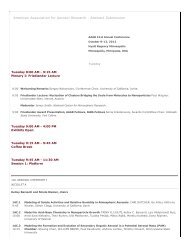Download PDF of Conference Program Book - AAARabstracts
Download PDF of Conference Program Book - AAARabstracts
Download PDF of Conference Program Book - AAARabstracts
- No tags were found...
Create successful ePaper yourself
Turn your PDF publications into a flip-book with our unique Google optimized e-Paper software.
cases. These include `traditional’ secondary organic<br />
aerosol formation experiments (including temperature<br />
effects), emissions characterization via dilution sampling,<br />
parcel mixing, and finally gas- and condensed-phase<br />
chemistry. We will discuss the relationships among<br />
various partitioning treatments (i.e., the VBS, Odum<br />
`2-product’ models, explicit mechanisms, etc.) as well<br />
as various mechanisms treating photochemical aging <strong>of</strong><br />
organic aerosol. Wall effects in chamber experiments will<br />
be given special consideration as an example problem.<br />
Neil Donahue is the director <strong>of</strong> the Center for Atmospheric<br />
Particle Studies at Carnegie Mellon University. He is<br />
a pr<strong>of</strong>essor <strong>of</strong> chemistry, chemical engineering, and<br />
engineering and public policy with broad research<br />
interests relating to all aspects <strong>of</strong> organic compounds<br />
in the atmosphere. In more than 100 peer-reviewed<br />
publications he has addressed questions ranging from<br />
non-methane hydrocarbon modeling and measurement<br />
in the remote marine atmosphere to laboratory kinetics<br />
<strong>of</strong> condensed-phase organic compounds. Pr<strong>of</strong>essor<br />
Donahue has been at Carnegie Mellon since 2000. He<br />
received a PhD in meteorology from MIT (1991) before<br />
pursuing postdoctoral work in physical chemistry at<br />
Harvard University under the supervision <strong>of</strong> Jim Anderson.<br />
14. MeASureMenTS <strong>of</strong> CArBon In The<br />
ATMoSphere<br />
Christopher D. Cappa, Department <strong>of</strong> Civil<br />
and Environmental Engineering, University <strong>of</strong><br />
California, Davis, CA<br />
Abstract: Carbon makes up a large fraction <strong>of</strong><br />
atmospheric aerosols. Aerosol carbon is commonly<br />
sub-divided into two general types: organic carbon<br />
and elemental (aka black) carbon. There are numerous<br />
methods for the measurement <strong>of</strong> these two types <strong>of</strong><br />
aerosol carbon. In this tutorial, an overview <strong>of</strong> many <strong>of</strong><br />
the available methods for the measurement <strong>of</strong> particulate<br />
carbon will be given. Basic operating principles will be<br />
presented, and the methods will be considered in terms <strong>of</strong><br />
quantitativeness, information content, time resolution, size<br />
resolution, ease <strong>of</strong> use and sensitivity. The discussion will<br />
be focused around methods and instrumentation that can<br />
be used for the measurement <strong>of</strong> organic carbon, elemental<br />
(black) carbon or both.<br />
www.AAAR.org<br />
Tutorials<br />
37



